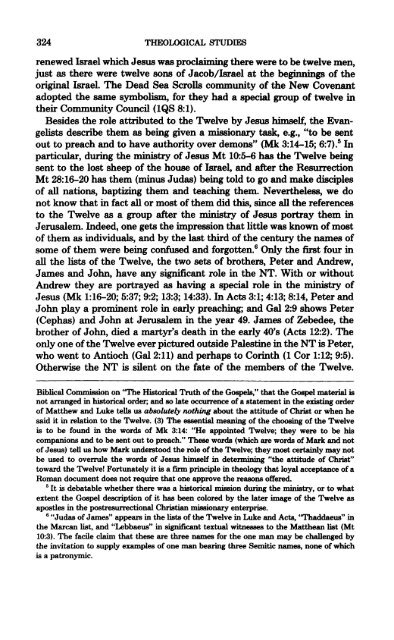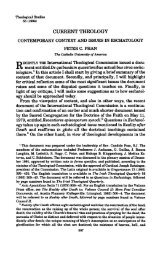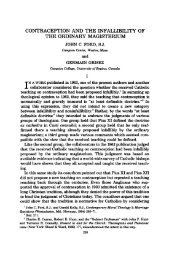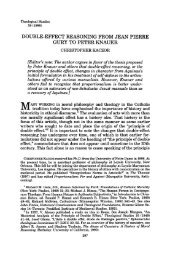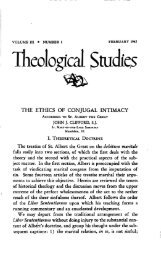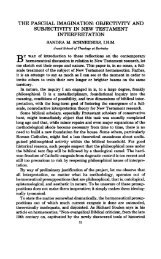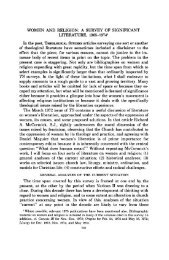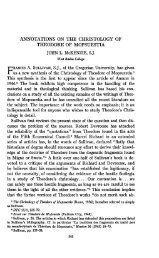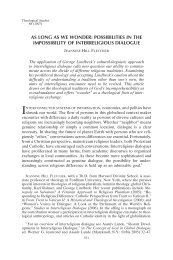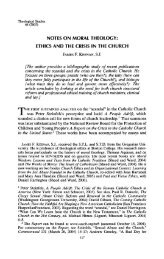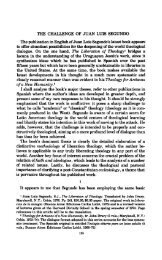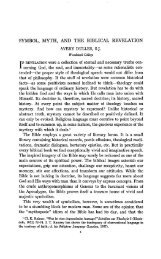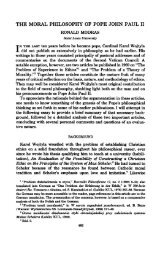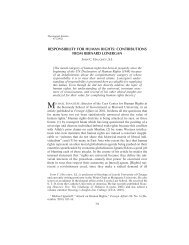episkopë and episkopos: the new testament evidence - Theological ...
episkopë and episkopos: the new testament evidence - Theological ...
episkopë and episkopos: the new testament evidence - Theological ...
You also want an ePaper? Increase the reach of your titles
YUMPU automatically turns print PDFs into web optimized ePapers that Google loves.
324 THEOLOGICAL STUDIES<br />
re<strong>new</strong>ed Israel which Jesus was proclaiming <strong>the</strong>re were to be twelve men,<br />
just as <strong>the</strong>re were twelve sons of Jacob/Israel at <strong>the</strong> beginnings of <strong>the</strong><br />
original Israel. The Dead Sea Scrolls community of <strong>the</strong> New Covenant<br />
adopted <strong>the</strong> same symbolism, for <strong>the</strong>y had a special group of twelve in<br />
<strong>the</strong>ir Community Council (1QS 8:1).<br />
Besides <strong>the</strong> role attributed to <strong>the</strong> Twelve by Jesus himself, <strong>the</strong> Evangelists<br />
describe <strong>the</strong>m as being given a missionary task, e.g., "to be sent<br />
out to preach <strong>and</strong> to have authority over demons" (Mk 3:14-15; 6:7). 5 In<br />
particular, during <strong>the</strong> ministry of Jesus Mt 10:5-6 has <strong>the</strong> Twelve being<br />
sent to <strong>the</strong> lost sheep of <strong>the</strong> house of Israel, <strong>and</strong> after <strong>the</strong> Resurrection<br />
Mt 28:16-20 has <strong>the</strong>m (minus Judas) being told to go <strong>and</strong> make disciples<br />
of all nations, baptizing <strong>the</strong>m <strong>and</strong> teaching <strong>the</strong>m. Never<strong>the</strong>less, we do<br />
not know that in fact all or most of <strong>the</strong>m did this, since all <strong>the</strong> references<br />
to <strong>the</strong> Twelve as a group after <strong>the</strong> ministry of Jesus portray <strong>the</strong>m in<br />
Jerusalem. Indeed, one gets <strong>the</strong> impression that little was known of most<br />
öf <strong>the</strong>m as individuals, <strong>and</strong> by <strong>the</strong> last third of <strong>the</strong> century <strong>the</strong> names of<br />
some of <strong>the</strong>m were being confused <strong>and</strong> forgotten. 6 Only <strong>the</strong> first four in<br />
all <strong>the</strong> lists of <strong>the</strong> Twelve, <strong>the</strong> two sets of bro<strong>the</strong>rs, Peter <strong>and</strong> Andrew,<br />
James <strong>and</strong> John, have any significant role in <strong>the</strong> NT. With or without<br />
Andrew <strong>the</strong>y are portrayed as having a special role in <strong>the</strong> ministry of<br />
Jesus (Mk 1:16-20; 5:37; 9:2; 13:3; 14:33). In Acts 3:1; 4:13; 8:14, Peter <strong>and</strong><br />
John play a prominent role in early preaching; <strong>and</strong> Gal 2:9 shows Peter<br />
(Cephas) <strong>and</strong> John at Jerusalem in <strong>the</strong> year 49. James of Zebedee, <strong>the</strong><br />
bro<strong>the</strong>r of John, died a martyr's death in <strong>the</strong> early 40's (Acts 12:2). The<br />
only one of <strong>the</strong> Twelve ever pictured outside Palestine in <strong>the</strong> NT is Peter,<br />
who went to Antioch (Gal 2:11) <strong>and</strong> perhaps to Corinth (1 Cor 1:12; 9:5).<br />
O<strong>the</strong>rwise <strong>the</strong> NT is silent on <strong>the</strong> fate of <strong>the</strong> members of <strong>the</strong> Twelve.<br />
Biblical Commission on "The Historical Truth of <strong>the</strong> Gospels," that <strong>the</strong> Gospel material is<br />
not arranged in historical order; <strong>and</strong> so late occurrence of a statement in <strong>the</strong> existing order<br />
of Mat<strong>the</strong>w <strong>and</strong> Luke tells us absolutely nothing about <strong>the</strong> attitude of Christ or when he<br />
said it in relation to <strong>the</strong> Twelve. (3) The essential meaning of <strong>the</strong> choosing of <strong>the</strong> Twelve<br />
is to be found in <strong>the</strong> words of Mk 3:14: "He appointed Twelve; <strong>the</strong>y were to be his<br />
companions <strong>and</strong> to be sent out to preach." These words (which are words of Mark <strong>and</strong> not<br />
of Jesus) tell us how Mark understood <strong>the</strong> role of <strong>the</strong> Twelve; <strong>the</strong>y most certainly may not<br />
be used to overrule <strong>the</strong> words of Jesus himself in determining "<strong>the</strong> attitude of Christ"<br />
toward <strong>the</strong> Twelve! Fortunately it is a firmprinciple in <strong>the</strong>ology that loyal acceptance of a<br />
Roman document does not require that one approve <strong>the</strong> reasons offered.<br />
5 It is debatable whe<strong>the</strong>r <strong>the</strong>re was a historical mission during <strong>the</strong> ministry, or to what<br />
extent <strong>the</strong> Gospel description of it has been colored by <strong>the</strong> later image of <strong>the</strong> Twelve as<br />
apostles in <strong>the</strong> postresurrectional Christian missionary enterprise.<br />
6 "Judas of James" appears in <strong>the</strong> lists of <strong>the</strong> Twelve in Luke <strong>and</strong> Acts, "Thaddaeus" in<br />
<strong>the</strong> Marcan list, <strong>and</strong> "Lebbaeus" in significant textual witnesses to <strong>the</strong> Mat<strong>the</strong>an list (Mt<br />
10:3). The facile claim that <strong>the</strong>se are three names for <strong>the</strong> one man may be challenged by<br />
<strong>the</strong> invitation to supply examples of one man bearing three Semitic names, none of which<br />
is a patronymic.


